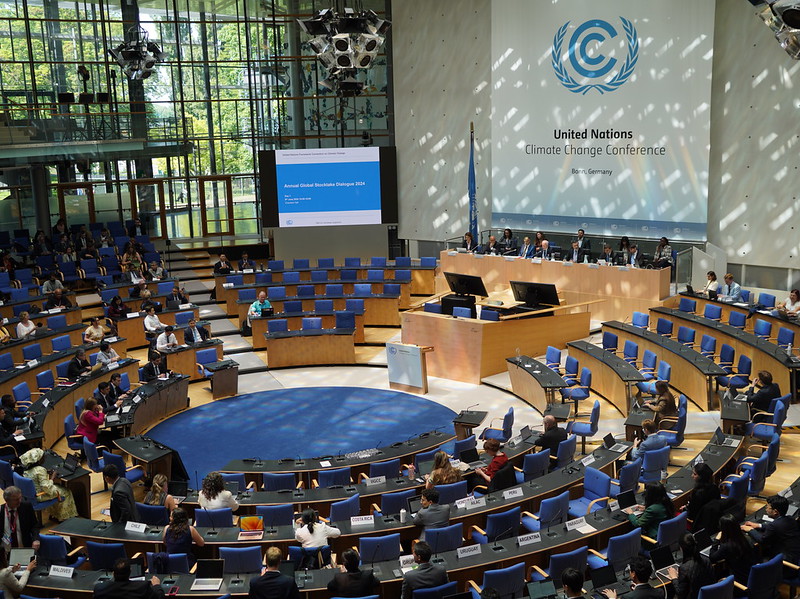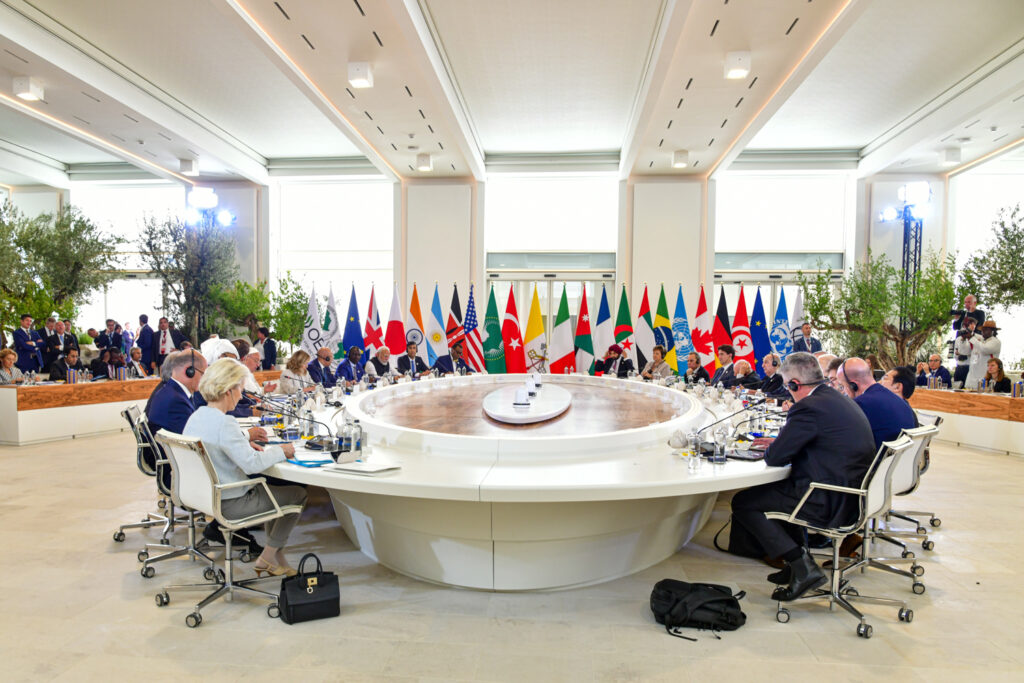Two crucial global talks, Bonn and G7, failed to agree on climate finance ahead of COP29 climate discussions. The crux of the problem, say experts, is that rich countries confuse investment with climate finance
At the annual mid-year UN climate talks in Germany’s Bonn, developed nations failed to agree on a new target to fund climate action in developing ones. Simultaneously, leaders of the Group of Seven (G7) rich countries of the world failed to provide substantial new funding commitments and offered little beyond reiterated vows of energy transition at their meeting in Italy.
Both these meetings were expected to define contours of the COP29 climate discussions in Baku later this year. The agenda of COP29 this November is to set a new financial goal for funds that the developed world is to make available to help developing nations, post 2025 to transition to a low-carbon future. This New Collective Quantified Goal (NCQG) on climate finance is expected to replace the failed pledge of developed nations to give $100 billion a year to developing countries by 2020.
Yet, negotiators in Bonn did not budge from their positions on key issues such as the quantum of finance for developing nations. More than quantum, it is the nature and source of finance–investment and loans or grants–that are contentious. There is no agreement on who should contribute, receive funds or qualify as “particularly vulnerable”, and the role of private finance.

The frustration at this failure to make any headway at Bonn and Italy by the G7 is palpable, yet hardly surprising.
Developed countries, including the US, while agreeing that the goals will be set from a floor of $100 billion, have not come forward with a number during Bonn talks. Meanwhile, developing nations, including Saudi Arabia, India and African countries, have called for at least $1-1.3 trillion in funding each year. The G77+China group consisting of 134 developing nations suggested rich nations could tax their defence, technology and fashion companies to raise $441 billion, which could help mobilise more than a trillion dollars along with private finance, Climate Home News reported in June.
This stark difference in funding expectations forms the crux of differences between the Global North and Global South.
“What we see is that countries from the Global North and the Global South really differ on how they see climate finance,” said Stela Herschmann, climate policy specialist at Climate Observatory in Brazil told CarbonCopy. “We are talking about two very different animals. And this is part of the roadblock preventing countries from moving forward on the debate.”
The United Nations Framework Convention on Climate Change upholds the principle of the Common But Differentiated Responsibilities (CBDR). The Convention also stipulates that financial assistance must flow from nations “with more resources to those less endowed and more vulnerable.” It clearly states that developed countries “shall provide financial resources to assist” developing countries.
“That is the sine qua non condition from developing countries that this is the goal,” said Herschmann. While developed countries have been “talking about having others contribute” leading to accusations that the rich nations are trying to rewrite the very convention, she said.

Defining Climate Finance
Ever since 1992, when 172 nations first gathered for the Earth Summit at Rio De Janeiro to discuss climate change, there has been one unaddressed elephant in the room—the actual costs of clean transition. Yet it was not until the Copenhagen accord of 2009 that developed nations committed to a goal of mobilising $100 billion each year by 2020 to address the needs of developing countries. The funds aimed to support both mitigation and adaptation efforts and led to the establishment of the Green Climate Fund.
Yet, global conversations on climate finance are still to agree on a very basic definition of the term in keeping with the CBDR principle. Developing nations hold the Convention, the Kyoto Protocol, and the Paris Agreement’s direction that rich countries should provide financial support to help developing ones fund mitigation and adaptation.
Even in Bonn, developing nations raise the issue of historical responsibilities of developed countries in creating climate change challenges. The idea was rejected by developed countries.
The UNFCCC defines climate finance as ‘local, national or transnational financing—drawn from public, private and alternative sources of financing—that seeks to support mitigation and adaptation actions that will address climate change’. Glaringly, it does not mention funds for losses and damage caused by the rising number of extreme events.
Such a definition that assumes any finance that supports climate change as climate finance, allows developed nations to narrowly define the term while sidestepping the CBDR principle, which pushes former colonial nations to shoulder a higher share of climate change costs.
According to the OECD’s Climate Finance Provided and Mobilised by Developed Countries in 2013-2022 report, while rich nations did meet their $100 billion goal, albeit two years late, the primary form of public climate finance remained loans. Lending to developing nations in the name of climate finance rose from US$49.6 billion in 2021 to US$63.6 billion in 2022. This meant interest earnings for richer nations, but an added unsustainable financial burden on climate-vulnerable countries.
The crux of the problem
None of the developing nations really agree with the OECD claim that the $100 billion target has been reached, according to Professor Thiagarajan Jayaraman, Senior Fellow in Climate Change at Chennai-based M.S. Swaminathan Research Foundation. If calculated under the measure called “in grant equivalent terms,” the amount is nowhere near $100 billion, he said.
“Finance has a very specific meaning under the convention and the Paris Agreement. And developing countries have been insisting that this definition be followed and be used as a basis to decide what is climate finance, and therefore also estimate whether there is sufficient climate finance or not,” Jayaraman said. “The developed countries, on the other hand, have constantly said that finance need not be public in character. They confuse investment with climate finance. This is the crux of the problem.”
And it is a problem that needs to be addressed urgently to put money on the table as global costs of worsening climate change impacts climb. The Independent High-Level Expert Group on Climate Finance, for instance, estimates that developing and emerging economies, excluding China, need $2.4 trillion each year by 2030 to close the financing gap for investments in mitigation and adaptation. Achieving sustainable development goals would require another $3.5 trillion a year. Similarly, the UN’s 2023 Trade and Development Report suggests that Low and Middle Income Countries need roughly $4 trillion per year to meet their climate and development goals.
“Best levers are reforms of multilateral development banks (MDBs, including general capital and callable capital increases, public concessional finance, including an increase in real terms for the 21st IDA replenishment, and new forms of international taxation,” according to Luca Bergmaschi, co-founding director of the Italy-based think-tank ECCO, who called the recent G7 meetings a “missed opportunity” for climate finance.
This November’s NCQG discussions are expected to address the much-needed MDB reforms, which has gained urgency given that international financial institutions, especially MDBs, have reduced lending to developing nations just when it is most needed.
A 2023 report by the G20’s Independent Expert Group showed that net transfers from the International Monetary Fund to low-and middle-income countries (LMICs) fell by $19 billion from 2022 to 2023, while those from the World Bank Group decreased by $6 billion. Overall, net resource transfers from MDBs turned negative in 2023, owing partly to a downturn in private financial flows.
Will COP29 deliver?
The scaling up of private finance to channel greater funds toward climate action in developing countries through carbon markets is also expected to be on the COP29 agenda.
But one of the biggest conflicts at the COP29 could be the spilling over of the western nations’ rivalry with China. The developed nations’ group have been seeking an increase in the NCQG contributor base. The group wants economically strong, high-emitting nations that are still considered “developing” countries, including China and the Arab states, to start contributing.
This was an idea that China criticised at Bonn saying it had no intention “to make your number look good or be part of your responsibility as we are doing all we can,” according to a Climate Home News report.
This year’s COP will take place just days after the US presidential election, with the possibility of a Donald Trump victory. It will also be held amid wars in Ukraine and Gaza and a raging trade war with the US and its EU allies aligning against China.
The US had in the last COP clearly indicated that its interest in climate finance is limited to making more space for corporations to bring in funds. For a nation that is funding two war fronts, its then Presidential Envoy for Climate John Kerry had declared to the media in Dubai last December that governments lack funds to save the world from climate change impacts.
“No government in the world has enough money to affect this transition. We wanted to be the nicest, best, biggest donor beyond where we are today. We don’t have the money. And we are the richest economy on the planet,” Kerry told a press conference at COP28. “In Glasgow, we worked together with the COP president Alok Sharma and they put together GFANS [Glasgow Financial Alliance for Net Zero]—the global alliance of asset owners and managers. Because they have the money. And they came up with $131 trillion that they felt would be ready to invest in climate-related activities IF you have a bankable deal. Most of them are subject to fiduciary rules. They are required to do due diligence.”
Developing nations may as well add a plan to negotiate against financialisation of the climate economy to their list of priorities.
About The Author
You may also like
What COP30 reveals about the next phase of multilateralism
The G20 Has Outrun COP on Climate Finance
As COP30 rolls out a tropical forest fund, how are India’s natural forests doing?
COP30 Kicks Off With Hard Talks on Money, Adaptation and Global South Leadership
Can multilateralism still deliver at COP30?

